Cross-Cultural Management: Hofstede's Model Analysis of UK and China
VerifiedAdded on 2020/04/15
|18
|4608
|39
Essay
AI Summary
This essay delves into the realm of cross-cultural management, offering a comparative analysis of the United Kingdom and China through the lens of Geert Hofstede's five-dimensional model. The essay meticulously examines each dimension – power distance, individualism versus collectivism, masculinity versus femininity, uncertainty avoidance, and long-term versus short-term orientation – to highlight the cultural nuances of both nations. It further explores the implications of these cultural differences in a business context, emphasizing the importance of understanding these aspects for successful global business strategies. Additionally, the essay touches upon the concept of work-life balance, discussing its significance and the role of organizations in fostering it. The analysis underscores the need for cross-cultural communication and comprehension in today's globalized business environment, offering insights into how cultural understanding can lead to stronger business relationships and successful ventures.
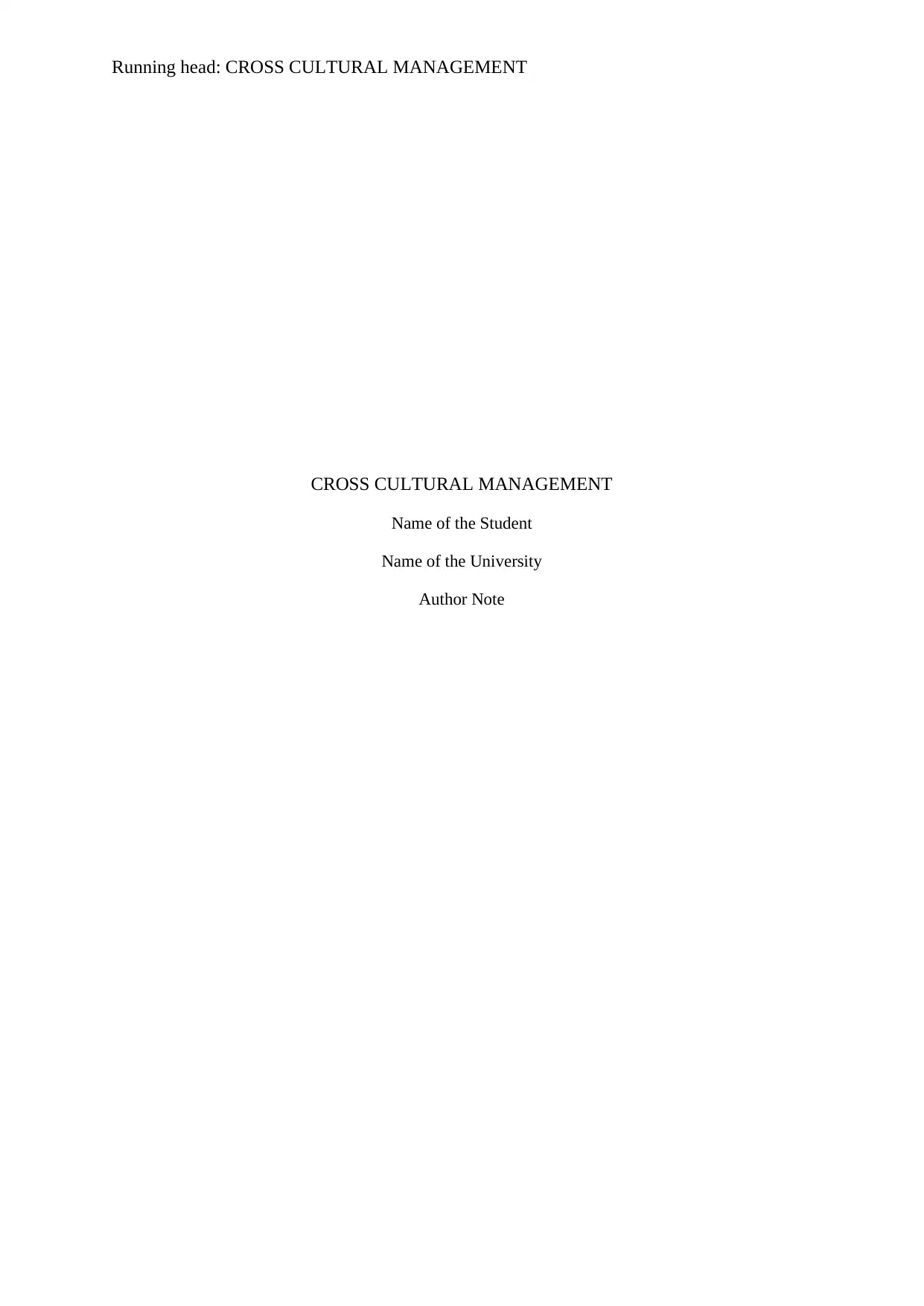
Running head: CROSS CULTURAL MANAGEMENT
CROSS CULTURAL MANAGEMENT
Name of the Student
Name of the University
Author Note
CROSS CULTURAL MANAGEMENT
Name of the Student
Name of the University
Author Note
Paraphrase This Document
Need a fresh take? Get an instant paraphrase of this document with our AI Paraphraser
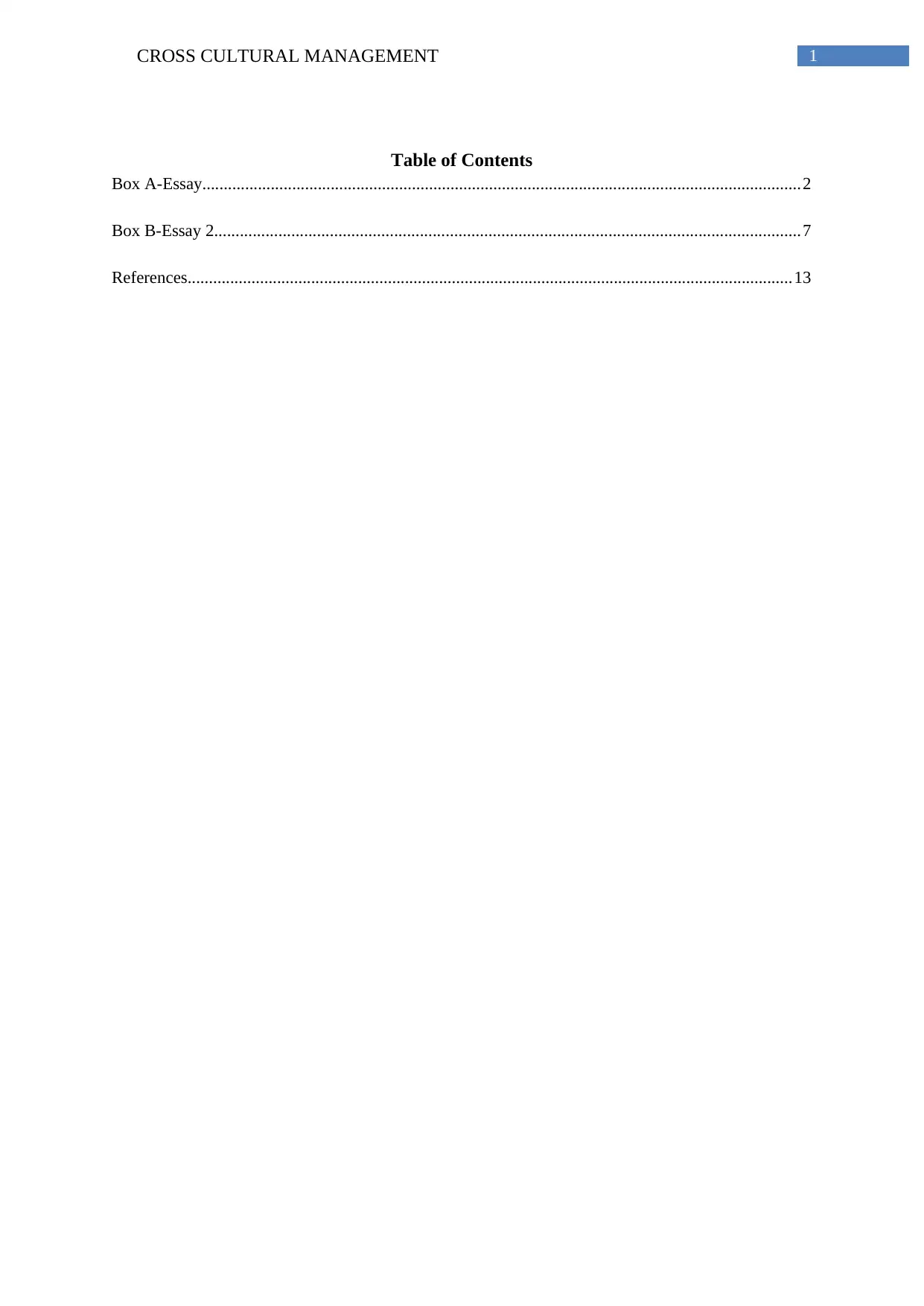
1CROSS CULTURAL MANAGEMENT
Table of Contents
Box A-Essay............................................................................................................................................2
Box B-Essay 2.........................................................................................................................................7
References..............................................................................................................................................13
Table of Contents
Box A-Essay............................................................................................................................................2
Box B-Essay 2.........................................................................................................................................7
References..............................................................................................................................................13
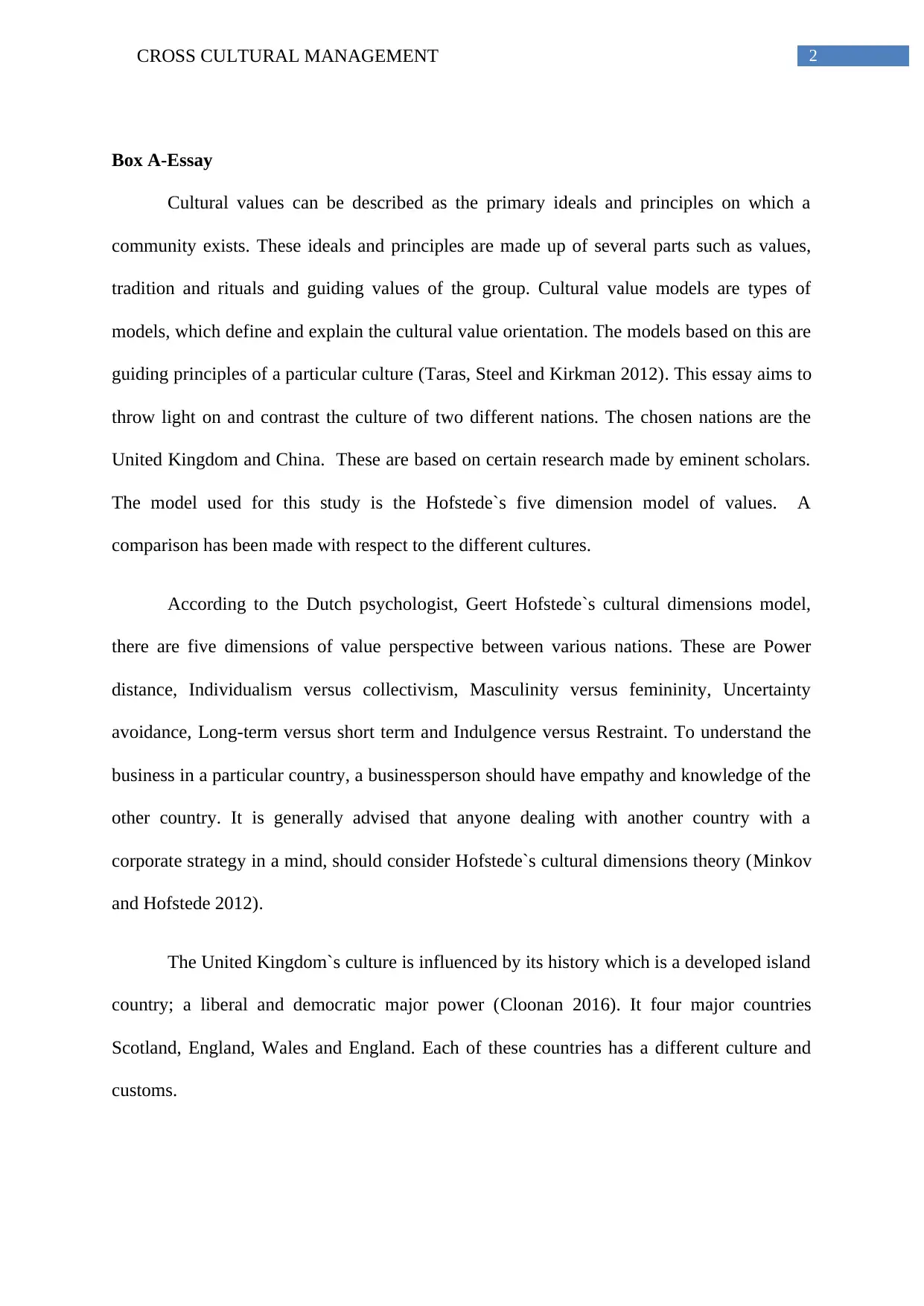
2CROSS CULTURAL MANAGEMENT
Box A-Essay
Cultural values can be described as the primary ideals and principles on which a
community exists. These ideals and principles are made up of several parts such as values,
tradition and rituals and guiding values of the group. Cultural value models are types of
models, which define and explain the cultural value orientation. The models based on this are
guiding principles of a particular culture (Taras, Steel and Kirkman 2012). This essay aims to
throw light on and contrast the culture of two different nations. The chosen nations are the
United Kingdom and China. These are based on certain research made by eminent scholars.
The model used for this study is the Hofstede`s five dimension model of values. A
comparison has been made with respect to the different cultures.
According to the Dutch psychologist, Geert Hofstede`s cultural dimensions model,
there are five dimensions of value perspective between various nations. These are Power
distance, Individualism versus collectivism, Masculinity versus femininity, Uncertainty
avoidance, Long-term versus short term and Indulgence versus Restraint. To understand the
business in a particular country, a businessperson should have empathy and knowledge of the
other country. It is generally advised that anyone dealing with another country with a
corporate strategy in a mind, should consider Hofstede`s cultural dimensions theory (Minkov
and Hofstede 2012).
The United Kingdom`s culture is influenced by its history which is a developed island
country; a liberal and democratic major power (Cloonan 2016). It four major countries
Scotland, England, Wales and England. Each of these countries has a different culture and
customs.
Box A-Essay
Cultural values can be described as the primary ideals and principles on which a
community exists. These ideals and principles are made up of several parts such as values,
tradition and rituals and guiding values of the group. Cultural value models are types of
models, which define and explain the cultural value orientation. The models based on this are
guiding principles of a particular culture (Taras, Steel and Kirkman 2012). This essay aims to
throw light on and contrast the culture of two different nations. The chosen nations are the
United Kingdom and China. These are based on certain research made by eminent scholars.
The model used for this study is the Hofstede`s five dimension model of values. A
comparison has been made with respect to the different cultures.
According to the Dutch psychologist, Geert Hofstede`s cultural dimensions model,
there are five dimensions of value perspective between various nations. These are Power
distance, Individualism versus collectivism, Masculinity versus femininity, Uncertainty
avoidance, Long-term versus short term and Indulgence versus Restraint. To understand the
business in a particular country, a businessperson should have empathy and knowledge of the
other country. It is generally advised that anyone dealing with another country with a
corporate strategy in a mind, should consider Hofstede`s cultural dimensions theory (Minkov
and Hofstede 2012).
The United Kingdom`s culture is influenced by its history which is a developed island
country; a liberal and democratic major power (Cloonan 2016). It four major countries
Scotland, England, Wales and England. Each of these countries has a different culture and
customs.
⊘ This is a preview!⊘
Do you want full access?
Subscribe today to unlock all pages.

Trusted by 1+ million students worldwide
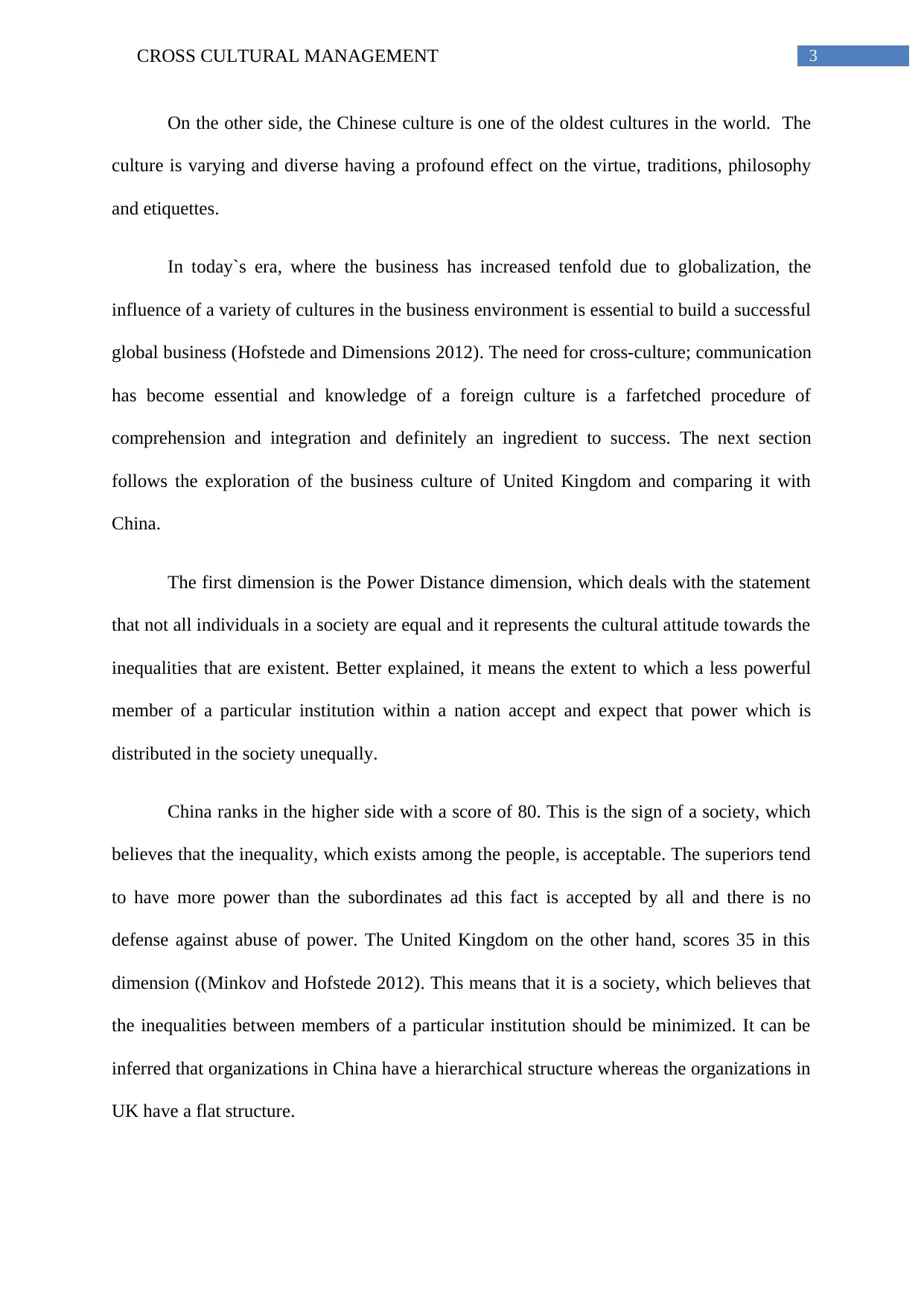
3CROSS CULTURAL MANAGEMENT
On the other side, the Chinese culture is one of the oldest cultures in the world. The
culture is varying and diverse having a profound effect on the virtue, traditions, philosophy
and etiquettes.
In today`s era, where the business has increased tenfold due to globalization, the
influence of a variety of cultures in the business environment is essential to build a successful
global business (Hofstede and Dimensions 2012). The need for cross-culture; communication
has become essential and knowledge of a foreign culture is a farfetched procedure of
comprehension and integration and definitely an ingredient to success. The next section
follows the exploration of the business culture of United Kingdom and comparing it with
China.
The first dimension is the Power Distance dimension, which deals with the statement
that not all individuals in a society are equal and it represents the cultural attitude towards the
inequalities that are existent. Better explained, it means the extent to which a less powerful
member of a particular institution within a nation accept and expect that power which is
distributed in the society unequally.
China ranks in the higher side with a score of 80. This is the sign of a society, which
believes that the inequality, which exists among the people, is acceptable. The superiors tend
to have more power than the subordinates ad this fact is accepted by all and there is no
defense against abuse of power. The United Kingdom on the other hand, scores 35 in this
dimension ((Minkov and Hofstede 2012). This means that it is a society, which believes that
the inequalities between members of a particular institution should be minimized. It can be
inferred that organizations in China have a hierarchical structure whereas the organizations in
UK have a flat structure.
On the other side, the Chinese culture is one of the oldest cultures in the world. The
culture is varying and diverse having a profound effect on the virtue, traditions, philosophy
and etiquettes.
In today`s era, where the business has increased tenfold due to globalization, the
influence of a variety of cultures in the business environment is essential to build a successful
global business (Hofstede and Dimensions 2012). The need for cross-culture; communication
has become essential and knowledge of a foreign culture is a farfetched procedure of
comprehension and integration and definitely an ingredient to success. The next section
follows the exploration of the business culture of United Kingdom and comparing it with
China.
The first dimension is the Power Distance dimension, which deals with the statement
that not all individuals in a society are equal and it represents the cultural attitude towards the
inequalities that are existent. Better explained, it means the extent to which a less powerful
member of a particular institution within a nation accept and expect that power which is
distributed in the society unequally.
China ranks in the higher side with a score of 80. This is the sign of a society, which
believes that the inequality, which exists among the people, is acceptable. The superiors tend
to have more power than the subordinates ad this fact is accepted by all and there is no
defense against abuse of power. The United Kingdom on the other hand, scores 35 in this
dimension ((Minkov and Hofstede 2012). This means that it is a society, which believes that
the inequalities between members of a particular institution should be minimized. It can be
inferred that organizations in China have a hierarchical structure whereas the organizations in
UK have a flat structure.
Paraphrase This Document
Need a fresh take? Get an instant paraphrase of this document with our AI Paraphraser
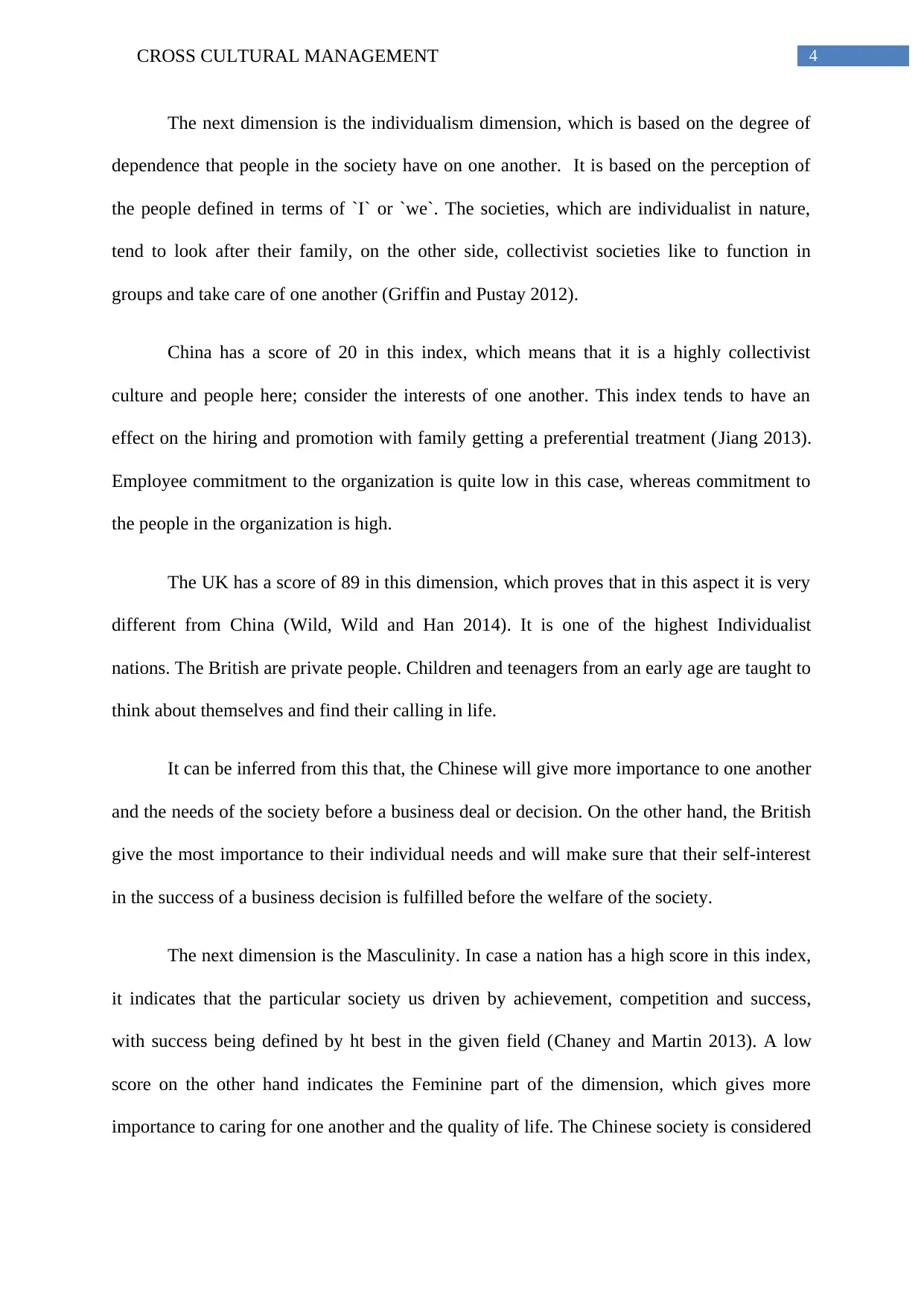
4CROSS CULTURAL MANAGEMENT
The next dimension is the individualism dimension, which is based on the degree of
dependence that people in the society have on one another. It is based on the perception of
the people defined in terms of `I` or `we`. The societies, which are individualist in nature,
tend to look after their family, on the other side, collectivist societies like to function in
groups and take care of one another (Griffin and Pustay 2012).
China has a score of 20 in this index, which means that it is a highly collectivist
culture and people here; consider the interests of one another. This index tends to have an
effect on the hiring and promotion with family getting a preferential treatment (Jiang 2013).
Employee commitment to the organization is quite low in this case, whereas commitment to
the people in the organization is high.
The UK has a score of 89 in this dimension, which proves that in this aspect it is very
different from China (Wild, Wild and Han 2014). It is one of the highest Individualist
nations. The British are private people. Children and teenagers from an early age are taught to
think about themselves and find their calling in life.
It can be inferred from this that, the Chinese will give more importance to one another
and the needs of the society before a business deal or decision. On the other hand, the British
give the most importance to their individual needs and will make sure that their self-interest
in the success of a business decision is fulfilled before the welfare of the society.
The next dimension is the Masculinity. In case a nation has a high score in this index,
it indicates that the particular society us driven by achievement, competition and success,
with success being defined by ht best in the given field (Chaney and Martin 2013). A low
score on the other hand indicates the Feminine part of the dimension, which gives more
importance to caring for one another and the quality of life. The Chinese society is considered
The next dimension is the individualism dimension, which is based on the degree of
dependence that people in the society have on one another. It is based on the perception of
the people defined in terms of `I` or `we`. The societies, which are individualist in nature,
tend to look after their family, on the other side, collectivist societies like to function in
groups and take care of one another (Griffin and Pustay 2012).
China has a score of 20 in this index, which means that it is a highly collectivist
culture and people here; consider the interests of one another. This index tends to have an
effect on the hiring and promotion with family getting a preferential treatment (Jiang 2013).
Employee commitment to the organization is quite low in this case, whereas commitment to
the people in the organization is high.
The UK has a score of 89 in this dimension, which proves that in this aspect it is very
different from China (Wild, Wild and Han 2014). It is one of the highest Individualist
nations. The British are private people. Children and teenagers from an early age are taught to
think about themselves and find their calling in life.
It can be inferred from this that, the Chinese will give more importance to one another
and the needs of the society before a business deal or decision. On the other hand, the British
give the most importance to their individual needs and will make sure that their self-interest
in the success of a business decision is fulfilled before the welfare of the society.
The next dimension is the Masculinity. In case a nation has a high score in this index,
it indicates that the particular society us driven by achievement, competition and success,
with success being defined by ht best in the given field (Chaney and Martin 2013). A low
score on the other hand indicates the Feminine part of the dimension, which gives more
importance to caring for one another and the quality of life. The Chinese society is considered
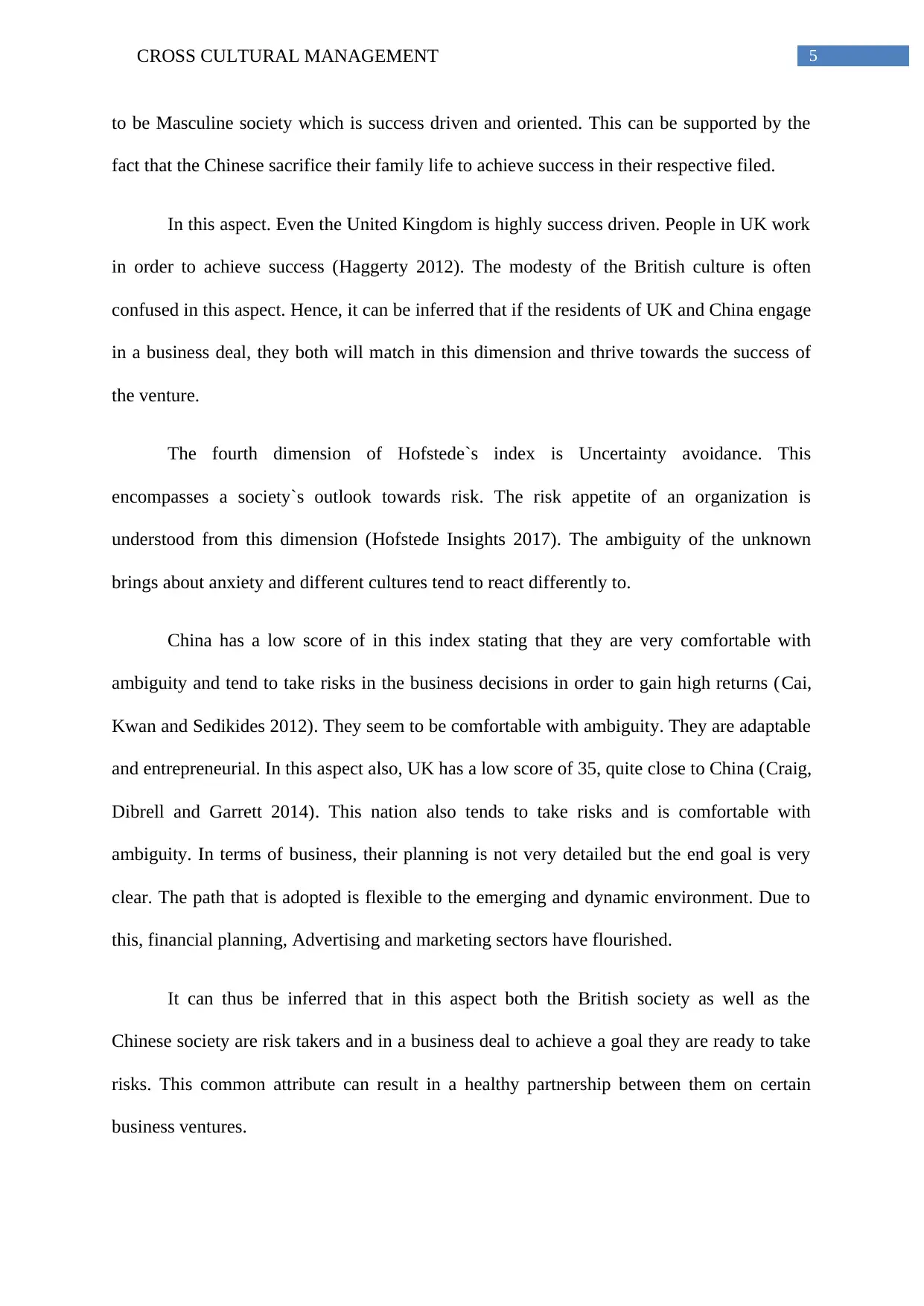
5CROSS CULTURAL MANAGEMENT
to be Masculine society which is success driven and oriented. This can be supported by the
fact that the Chinese sacrifice their family life to achieve success in their respective filed.
In this aspect. Even the United Kingdom is highly success driven. People in UK work
in order to achieve success (Haggerty 2012). The modesty of the British culture is often
confused in this aspect. Hence, it can be inferred that if the residents of UK and China engage
in a business deal, they both will match in this dimension and thrive towards the success of
the venture.
The fourth dimension of Hofstede`s index is Uncertainty avoidance. This
encompasses a society`s outlook towards risk. The risk appetite of an organization is
understood from this dimension (Hofstede Insights 2017). The ambiguity of the unknown
brings about anxiety and different cultures tend to react differently to.
China has a low score of in this index stating that they are very comfortable with
ambiguity and tend to take risks in the business decisions in order to gain high returns (Cai,
Kwan and Sedikides 2012). They seem to be comfortable with ambiguity. They are adaptable
and entrepreneurial. In this aspect also, UK has a low score of 35, quite close to China (Craig,
Dibrell and Garrett 2014). This nation also tends to take risks and is comfortable with
ambiguity. In terms of business, their planning is not very detailed but the end goal is very
clear. The path that is adopted is flexible to the emerging and dynamic environment. Due to
this, financial planning, Advertising and marketing sectors have flourished.
It can thus be inferred that in this aspect both the British society as well as the
Chinese society are risk takers and in a business deal to achieve a goal they are ready to take
risks. This common attribute can result in a healthy partnership between them on certain
business ventures.
to be Masculine society which is success driven and oriented. This can be supported by the
fact that the Chinese sacrifice their family life to achieve success in their respective filed.
In this aspect. Even the United Kingdom is highly success driven. People in UK work
in order to achieve success (Haggerty 2012). The modesty of the British culture is often
confused in this aspect. Hence, it can be inferred that if the residents of UK and China engage
in a business deal, they both will match in this dimension and thrive towards the success of
the venture.
The fourth dimension of Hofstede`s index is Uncertainty avoidance. This
encompasses a society`s outlook towards risk. The risk appetite of an organization is
understood from this dimension (Hofstede Insights 2017). The ambiguity of the unknown
brings about anxiety and different cultures tend to react differently to.
China has a low score of in this index stating that they are very comfortable with
ambiguity and tend to take risks in the business decisions in order to gain high returns (Cai,
Kwan and Sedikides 2012). They seem to be comfortable with ambiguity. They are adaptable
and entrepreneurial. In this aspect also, UK has a low score of 35, quite close to China (Craig,
Dibrell and Garrett 2014). This nation also tends to take risks and is comfortable with
ambiguity. In terms of business, their planning is not very detailed but the end goal is very
clear. The path that is adopted is flexible to the emerging and dynamic environment. Due to
this, financial planning, Advertising and marketing sectors have flourished.
It can thus be inferred that in this aspect both the British society as well as the
Chinese society are risk takers and in a business deal to achieve a goal they are ready to take
risks. This common attribute can result in a healthy partnership between them on certain
business ventures.
⊘ This is a preview!⊘
Do you want full access?
Subscribe today to unlock all pages.

Trusted by 1+ million students worldwide
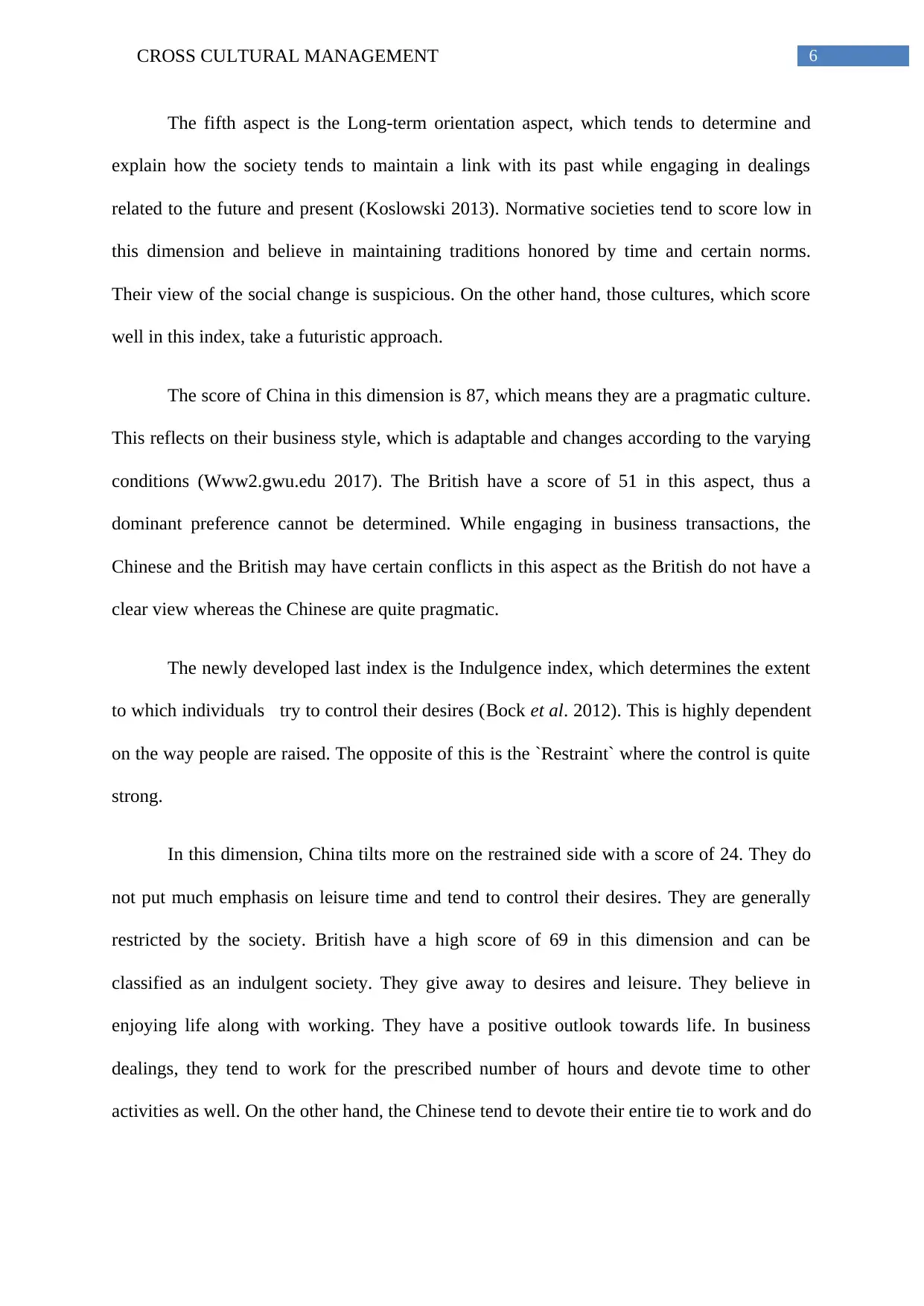
6CROSS CULTURAL MANAGEMENT
The fifth aspect is the Long-term orientation aspect, which tends to determine and
explain how the society tends to maintain a link with its past while engaging in dealings
related to the future and present (Koslowski 2013). Normative societies tend to score low in
this dimension and believe in maintaining traditions honored by time and certain norms.
Their view of the social change is suspicious. On the other hand, those cultures, which score
well in this index, take a futuristic approach.
The score of China in this dimension is 87, which means they are a pragmatic culture.
This reflects on their business style, which is adaptable and changes according to the varying
conditions (Www2.gwu.edu 2017). The British have a score of 51 in this aspect, thus a
dominant preference cannot be determined. While engaging in business transactions, the
Chinese and the British may have certain conflicts in this aspect as the British do not have a
clear view whereas the Chinese are quite pragmatic.
The newly developed last index is the Indulgence index, which determines the extent
to which individuals try to control their desires (Bock et al. 2012). This is highly dependent
on the way people are raised. The opposite of this is the `Restraint` where the control is quite
strong.
In this dimension, China tilts more on the restrained side with a score of 24. They do
not put much emphasis on leisure time and tend to control their desires. They are generally
restricted by the society. British have a high score of 69 in this dimension and can be
classified as an indulgent society. They give away to desires and leisure. They believe in
enjoying life along with working. They have a positive outlook towards life. In business
dealings, they tend to work for the prescribed number of hours and devote time to other
activities as well. On the other hand, the Chinese tend to devote their entire tie to work and do
The fifth aspect is the Long-term orientation aspect, which tends to determine and
explain how the society tends to maintain a link with its past while engaging in dealings
related to the future and present (Koslowski 2013). Normative societies tend to score low in
this dimension and believe in maintaining traditions honored by time and certain norms.
Their view of the social change is suspicious. On the other hand, those cultures, which score
well in this index, take a futuristic approach.
The score of China in this dimension is 87, which means they are a pragmatic culture.
This reflects on their business style, which is adaptable and changes according to the varying
conditions (Www2.gwu.edu 2017). The British have a score of 51 in this aspect, thus a
dominant preference cannot be determined. While engaging in business transactions, the
Chinese and the British may have certain conflicts in this aspect as the British do not have a
clear view whereas the Chinese are quite pragmatic.
The newly developed last index is the Indulgence index, which determines the extent
to which individuals try to control their desires (Bock et al. 2012). This is highly dependent
on the way people are raised. The opposite of this is the `Restraint` where the control is quite
strong.
In this dimension, China tilts more on the restrained side with a score of 24. They do
not put much emphasis on leisure time and tend to control their desires. They are generally
restricted by the society. British have a high score of 69 in this dimension and can be
classified as an indulgent society. They give away to desires and leisure. They believe in
enjoying life along with working. They have a positive outlook towards life. In business
dealings, they tend to work for the prescribed number of hours and devote time to other
activities as well. On the other hand, the Chinese tend to devote their entire tie to work and do
Paraphrase This Document
Need a fresh take? Get an instant paraphrase of this document with our AI Paraphraser
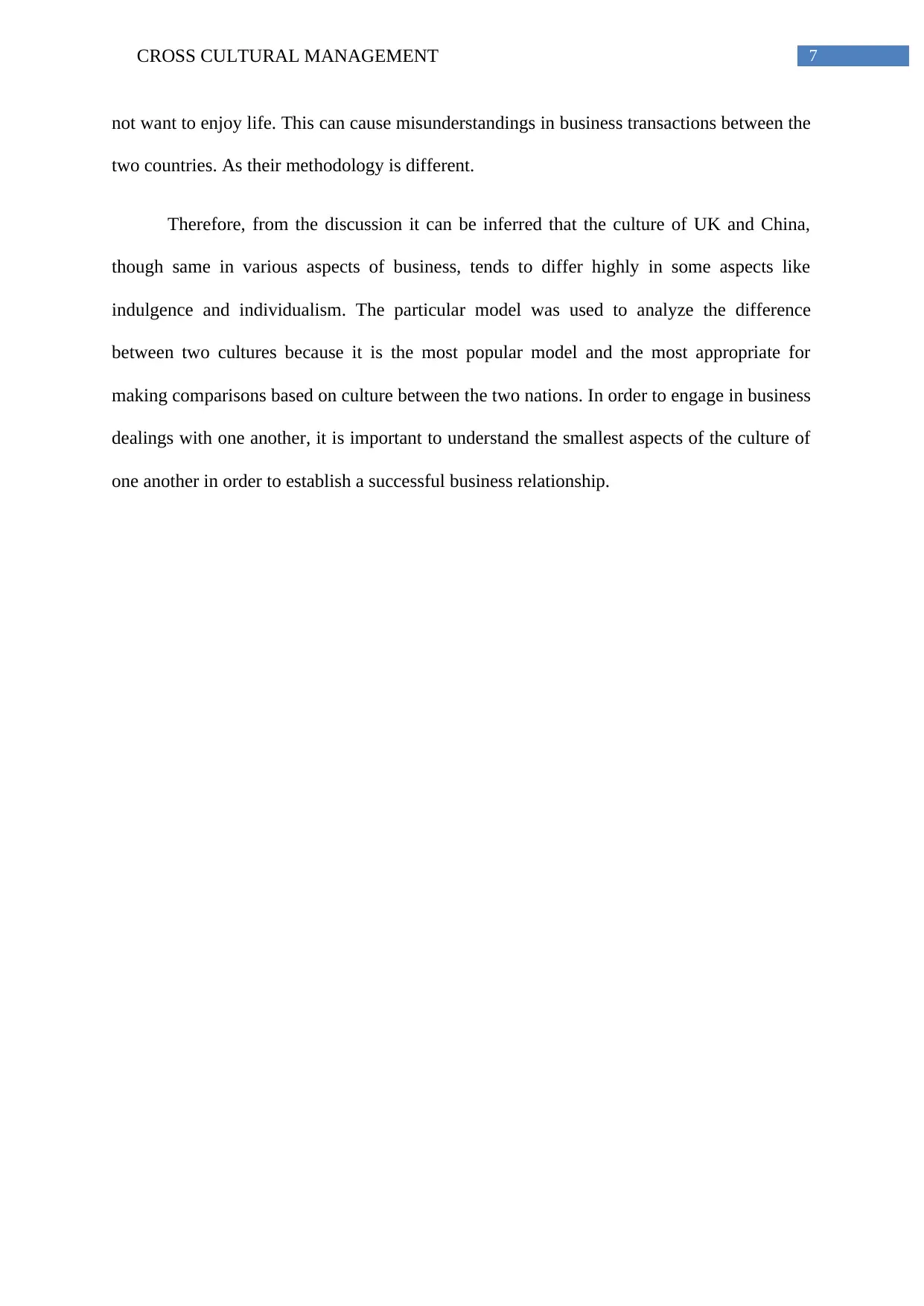
7CROSS CULTURAL MANAGEMENT
not want to enjoy life. This can cause misunderstandings in business transactions between the
two countries. As their methodology is different.
Therefore, from the discussion it can be inferred that the culture of UK and China,
though same in various aspects of business, tends to differ highly in some aspects like
indulgence and individualism. The particular model was used to analyze the difference
between two cultures because it is the most popular model and the most appropriate for
making comparisons based on culture between the two nations. In order to engage in business
dealings with one another, it is important to understand the smallest aspects of the culture of
one another in order to establish a successful business relationship.
not want to enjoy life. This can cause misunderstandings in business transactions between the
two countries. As their methodology is different.
Therefore, from the discussion it can be inferred that the culture of UK and China,
though same in various aspects of business, tends to differ highly in some aspects like
indulgence and individualism. The particular model was used to analyze the difference
between two cultures because it is the most popular model and the most appropriate for
making comparisons based on culture between the two nations. In order to engage in business
dealings with one another, it is important to understand the smallest aspects of the culture of
one another in order to establish a successful business relationship.
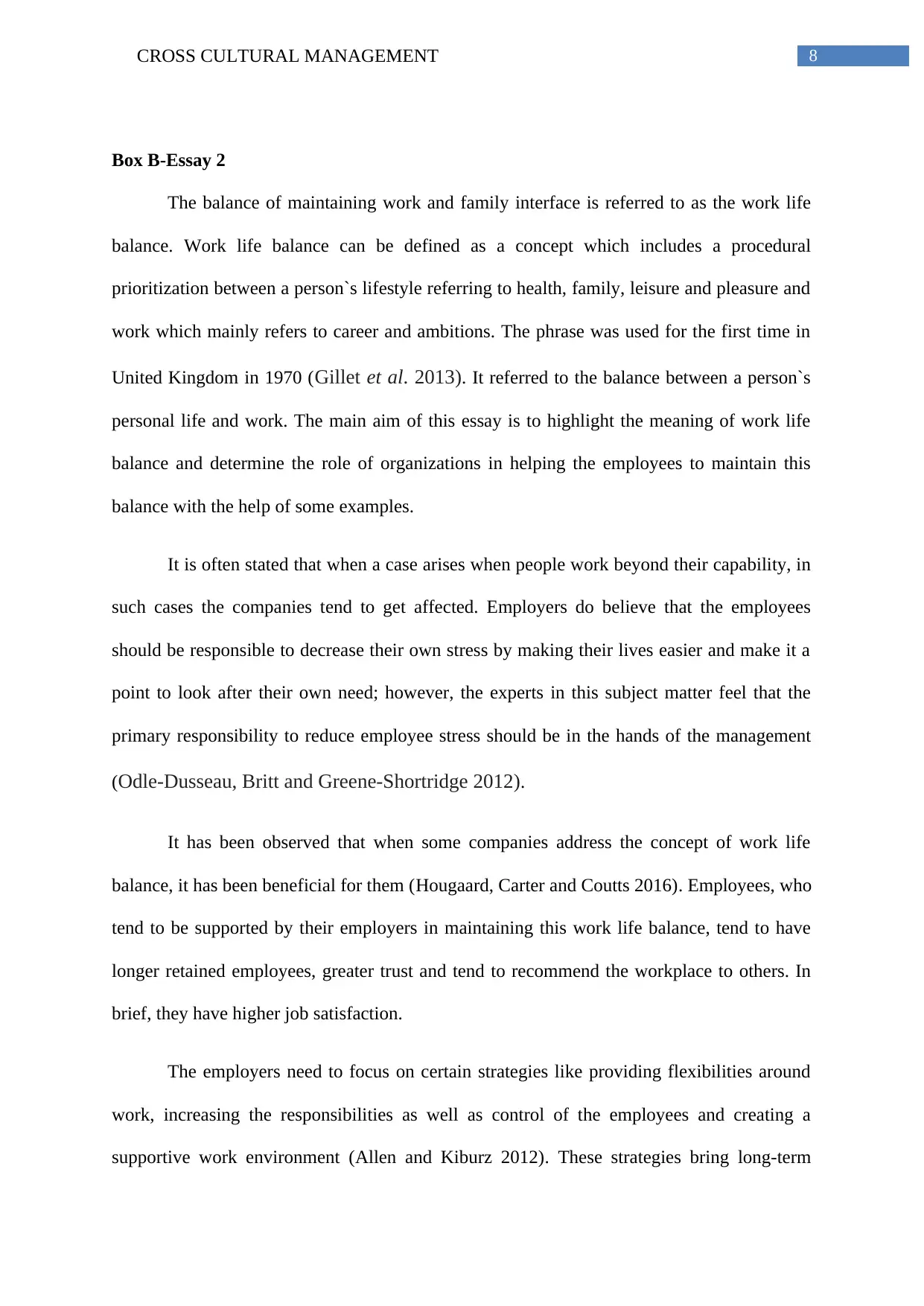
8CROSS CULTURAL MANAGEMENT
Box B-Essay 2
The balance of maintaining work and family interface is referred to as the work life
balance. Work life balance can be defined as a concept which includes a procedural
prioritization between a person`s lifestyle referring to health, family, leisure and pleasure and
work which mainly refers to career and ambitions. The phrase was used for the first time in
United Kingdom in 1970 (Gillet et al. 2013). It referred to the balance between a person`s
personal life and work. The main aim of this essay is to highlight the meaning of work life
balance and determine the role of organizations in helping the employees to maintain this
balance with the help of some examples.
It is often stated that when a case arises when people work beyond their capability, in
such cases the companies tend to get affected. Employers do believe that the employees
should be responsible to decrease their own stress by making their lives easier and make it a
point to look after their own need; however, the experts in this subject matter feel that the
primary responsibility to reduce employee stress should be in the hands of the management
(Odle-Dusseau, Britt and Greene-Shortridge 2012).
It has been observed that when some companies address the concept of work life
balance, it has been beneficial for them (Hougaard, Carter and Coutts 2016). Employees, who
tend to be supported by their employers in maintaining this work life balance, tend to have
longer retained employees, greater trust and tend to recommend the workplace to others. In
brief, they have higher job satisfaction.
The employers need to focus on certain strategies like providing flexibilities around
work, increasing the responsibilities as well as control of the employees and creating a
supportive work environment (Allen and Kiburz 2012). These strategies bring long-term
Box B-Essay 2
The balance of maintaining work and family interface is referred to as the work life
balance. Work life balance can be defined as a concept which includes a procedural
prioritization between a person`s lifestyle referring to health, family, leisure and pleasure and
work which mainly refers to career and ambitions. The phrase was used for the first time in
United Kingdom in 1970 (Gillet et al. 2013). It referred to the balance between a person`s
personal life and work. The main aim of this essay is to highlight the meaning of work life
balance and determine the role of organizations in helping the employees to maintain this
balance with the help of some examples.
It is often stated that when a case arises when people work beyond their capability, in
such cases the companies tend to get affected. Employers do believe that the employees
should be responsible to decrease their own stress by making their lives easier and make it a
point to look after their own need; however, the experts in this subject matter feel that the
primary responsibility to reduce employee stress should be in the hands of the management
(Odle-Dusseau, Britt and Greene-Shortridge 2012).
It has been observed that when some companies address the concept of work life
balance, it has been beneficial for them (Hougaard, Carter and Coutts 2016). Employees, who
tend to be supported by their employers in maintaining this work life balance, tend to have
longer retained employees, greater trust and tend to recommend the workplace to others. In
brief, they have higher job satisfaction.
The employers need to focus on certain strategies like providing flexibilities around
work, increasing the responsibilities as well as control of the employees and creating a
supportive work environment (Allen and Kiburz 2012). These strategies bring long-term
⊘ This is a preview!⊘
Do you want full access?
Subscribe today to unlock all pages.

Trusted by 1+ million students worldwide
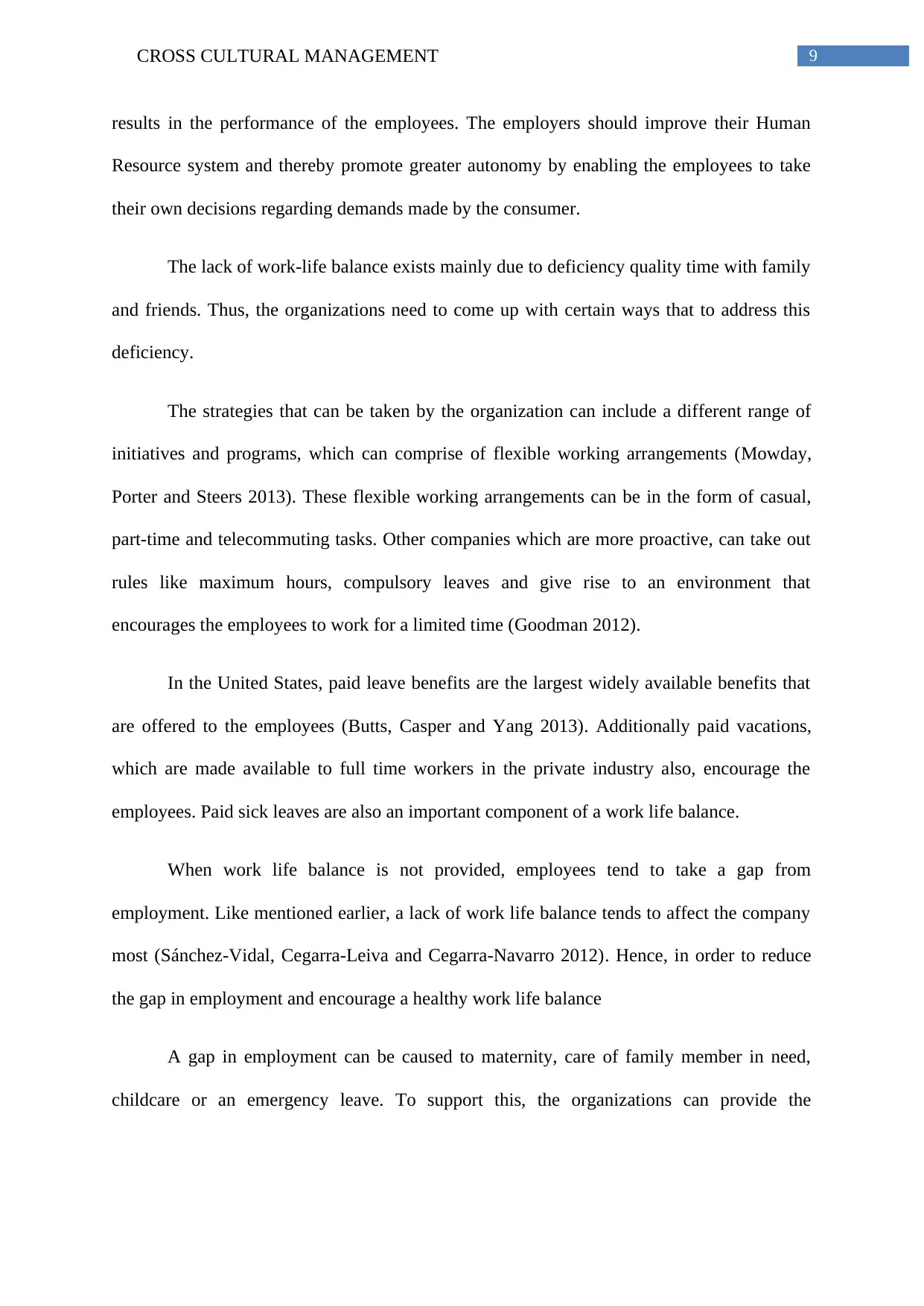
9CROSS CULTURAL MANAGEMENT
results in the performance of the employees. The employers should improve their Human
Resource system and thereby promote greater autonomy by enabling the employees to take
their own decisions regarding demands made by the consumer.
The lack of work-life balance exists mainly due to deficiency quality time with family
and friends. Thus, the organizations need to come up with certain ways that to address this
deficiency.
The strategies that can be taken by the organization can include a different range of
initiatives and programs, which can comprise of flexible working arrangements (Mowday,
Porter and Steers 2013). These flexible working arrangements can be in the form of casual,
part-time and telecommuting tasks. Other companies which are more proactive, can take out
rules like maximum hours, compulsory leaves and give rise to an environment that
encourages the employees to work for a limited time (Goodman 2012).
In the United States, paid leave benefits are the largest widely available benefits that
are offered to the employees (Butts, Casper and Yang 2013). Additionally paid vacations,
which are made available to full time workers in the private industry also, encourage the
employees. Paid sick leaves are also an important component of a work life balance.
When work life balance is not provided, employees tend to take a gap from
employment. Like mentioned earlier, a lack of work life balance tends to affect the company
most (Sánchez-Vidal, Cegarra-Leiva and Cegarra-Navarro 2012). Hence, in order to reduce
the gap in employment and encourage a healthy work life balance
A gap in employment can be caused to maternity, care of family member in need,
childcare or an emergency leave. To support this, the organizations can provide the
results in the performance of the employees. The employers should improve their Human
Resource system and thereby promote greater autonomy by enabling the employees to take
their own decisions regarding demands made by the consumer.
The lack of work-life balance exists mainly due to deficiency quality time with family
and friends. Thus, the organizations need to come up with certain ways that to address this
deficiency.
The strategies that can be taken by the organization can include a different range of
initiatives and programs, which can comprise of flexible working arrangements (Mowday,
Porter and Steers 2013). These flexible working arrangements can be in the form of casual,
part-time and telecommuting tasks. Other companies which are more proactive, can take out
rules like maximum hours, compulsory leaves and give rise to an environment that
encourages the employees to work for a limited time (Goodman 2012).
In the United States, paid leave benefits are the largest widely available benefits that
are offered to the employees (Butts, Casper and Yang 2013). Additionally paid vacations,
which are made available to full time workers in the private industry also, encourage the
employees. Paid sick leaves are also an important component of a work life balance.
When work life balance is not provided, employees tend to take a gap from
employment. Like mentioned earlier, a lack of work life balance tends to affect the company
most (Sánchez-Vidal, Cegarra-Leiva and Cegarra-Navarro 2012). Hence, in order to reduce
the gap in employment and encourage a healthy work life balance
A gap in employment can be caused to maternity, care of family member in need,
childcare or an emergency leave. To support this, the organizations can provide the
Paraphrase This Document
Need a fresh take? Get an instant paraphrase of this document with our AI Paraphraser
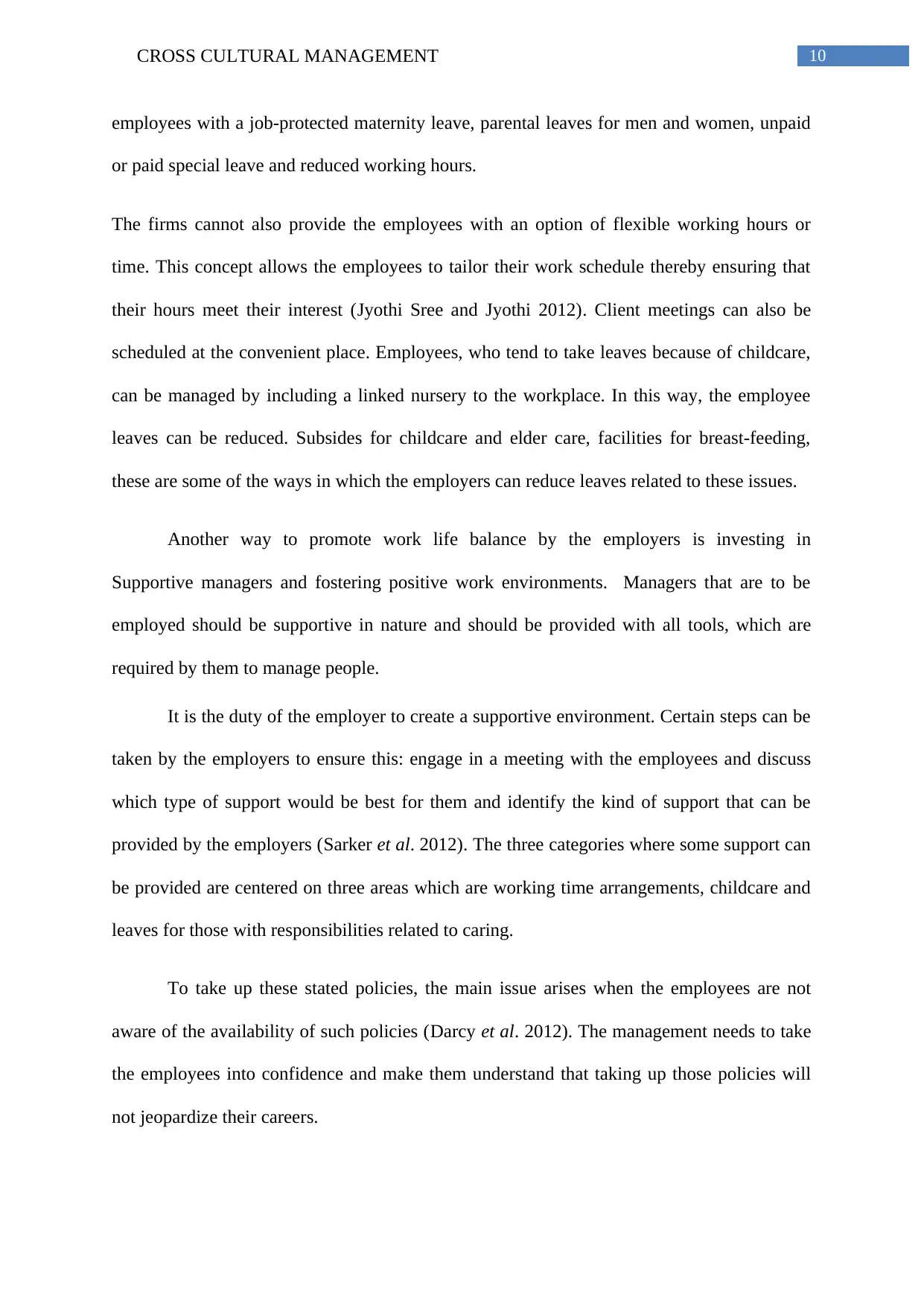
10CROSS CULTURAL MANAGEMENT
employees with a job-protected maternity leave, parental leaves for men and women, unpaid
or paid special leave and reduced working hours.
The firms cannot also provide the employees with an option of flexible working hours or
time. This concept allows the employees to tailor their work schedule thereby ensuring that
their hours meet their interest (Jyothi Sree and Jyothi 2012). Client meetings can also be
scheduled at the convenient place. Employees, who tend to take leaves because of childcare,
can be managed by including a linked nursery to the workplace. In this way, the employee
leaves can be reduced. Subsides for childcare and elder care, facilities for breast-feeding,
these are some of the ways in which the employers can reduce leaves related to these issues.
Another way to promote work life balance by the employers is investing in
Supportive managers and fostering positive work environments. Managers that are to be
employed should be supportive in nature and should be provided with all tools, which are
required by them to manage people.
It is the duty of the employer to create a supportive environment. Certain steps can be
taken by the employers to ensure this: engage in a meeting with the employees and discuss
which type of support would be best for them and identify the kind of support that can be
provided by the employers (Sarker et al. 2012). The three categories where some support can
be provided are centered on three areas which are working time arrangements, childcare and
leaves for those with responsibilities related to caring.
To take up these stated policies, the main issue arises when the employees are not
aware of the availability of such policies (Darcy et al. 2012). The management needs to take
the employees into confidence and make them understand that taking up those policies will
not jeopardize their careers.
employees with a job-protected maternity leave, parental leaves for men and women, unpaid
or paid special leave and reduced working hours.
The firms cannot also provide the employees with an option of flexible working hours or
time. This concept allows the employees to tailor their work schedule thereby ensuring that
their hours meet their interest (Jyothi Sree and Jyothi 2012). Client meetings can also be
scheduled at the convenient place. Employees, who tend to take leaves because of childcare,
can be managed by including a linked nursery to the workplace. In this way, the employee
leaves can be reduced. Subsides for childcare and elder care, facilities for breast-feeding,
these are some of the ways in which the employers can reduce leaves related to these issues.
Another way to promote work life balance by the employers is investing in
Supportive managers and fostering positive work environments. Managers that are to be
employed should be supportive in nature and should be provided with all tools, which are
required by them to manage people.
It is the duty of the employer to create a supportive environment. Certain steps can be
taken by the employers to ensure this: engage in a meeting with the employees and discuss
which type of support would be best for them and identify the kind of support that can be
provided by the employers (Sarker et al. 2012). The three categories where some support can
be provided are centered on three areas which are working time arrangements, childcare and
leaves for those with responsibilities related to caring.
To take up these stated policies, the main issue arises when the employees are not
aware of the availability of such policies (Darcy et al. 2012). The management needs to take
the employees into confidence and make them understand that taking up those policies will
not jeopardize their careers.
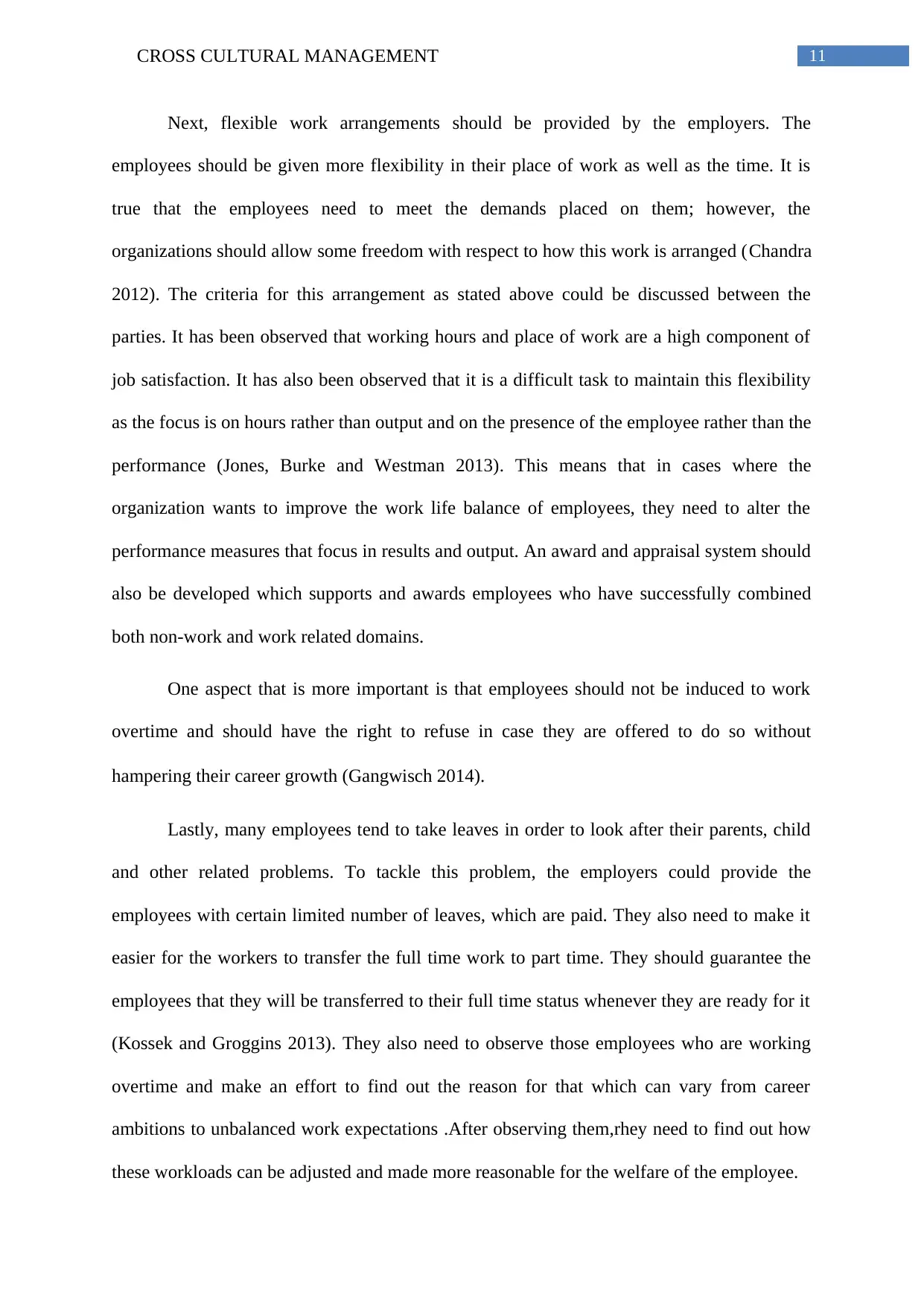
11CROSS CULTURAL MANAGEMENT
Next, flexible work arrangements should be provided by the employers. The
employees should be given more flexibility in their place of work as well as the time. It is
true that the employees need to meet the demands placed on them; however, the
organizations should allow some freedom with respect to how this work is arranged (Chandra
2012). The criteria for this arrangement as stated above could be discussed between the
parties. It has been observed that working hours and place of work are a high component of
job satisfaction. It has also been observed that it is a difficult task to maintain this flexibility
as the focus is on hours rather than output and on the presence of the employee rather than the
performance (Jones, Burke and Westman 2013). This means that in cases where the
organization wants to improve the work life balance of employees, they need to alter the
performance measures that focus in results and output. An award and appraisal system should
also be developed which supports and awards employees who have successfully combined
both non-work and work related domains.
One aspect that is more important is that employees should not be induced to work
overtime and should have the right to refuse in case they are offered to do so without
hampering their career growth (Gangwisch 2014).
Lastly, many employees tend to take leaves in order to look after their parents, child
and other related problems. To tackle this problem, the employers could provide the
employees with certain limited number of leaves, which are paid. They also need to make it
easier for the workers to transfer the full time work to part time. They should guarantee the
employees that they will be transferred to their full time status whenever they are ready for it
(Kossek and Groggins 2013). They also need to observe those employees who are working
overtime and make an effort to find out the reason for that which can vary from career
ambitions to unbalanced work expectations .After observing them,rhey need to find out how
these workloads can be adjusted and made more reasonable for the welfare of the employee.
Next, flexible work arrangements should be provided by the employers. The
employees should be given more flexibility in their place of work as well as the time. It is
true that the employees need to meet the demands placed on them; however, the
organizations should allow some freedom with respect to how this work is arranged (Chandra
2012). The criteria for this arrangement as stated above could be discussed between the
parties. It has been observed that working hours and place of work are a high component of
job satisfaction. It has also been observed that it is a difficult task to maintain this flexibility
as the focus is on hours rather than output and on the presence of the employee rather than the
performance (Jones, Burke and Westman 2013). This means that in cases where the
organization wants to improve the work life balance of employees, they need to alter the
performance measures that focus in results and output. An award and appraisal system should
also be developed which supports and awards employees who have successfully combined
both non-work and work related domains.
One aspect that is more important is that employees should not be induced to work
overtime and should have the right to refuse in case they are offered to do so without
hampering their career growth (Gangwisch 2014).
Lastly, many employees tend to take leaves in order to look after their parents, child
and other related problems. To tackle this problem, the employers could provide the
employees with certain limited number of leaves, which are paid. They also need to make it
easier for the workers to transfer the full time work to part time. They should guarantee the
employees that they will be transferred to their full time status whenever they are ready for it
(Kossek and Groggins 2013). They also need to observe those employees who are working
overtime and make an effort to find out the reason for that which can vary from career
ambitions to unbalanced work expectations .After observing them,rhey need to find out how
these workloads can be adjusted and made more reasonable for the welfare of the employee.
⊘ This is a preview!⊘
Do you want full access?
Subscribe today to unlock all pages.

Trusted by 1+ million students worldwide
1 out of 18
Related Documents
Your All-in-One AI-Powered Toolkit for Academic Success.
+13062052269
info@desklib.com
Available 24*7 on WhatsApp / Email
![[object Object]](/_next/static/media/star-bottom.7253800d.svg)
Unlock your academic potential
Copyright © 2020–2025 A2Z Services. All Rights Reserved. Developed and managed by ZUCOL.





